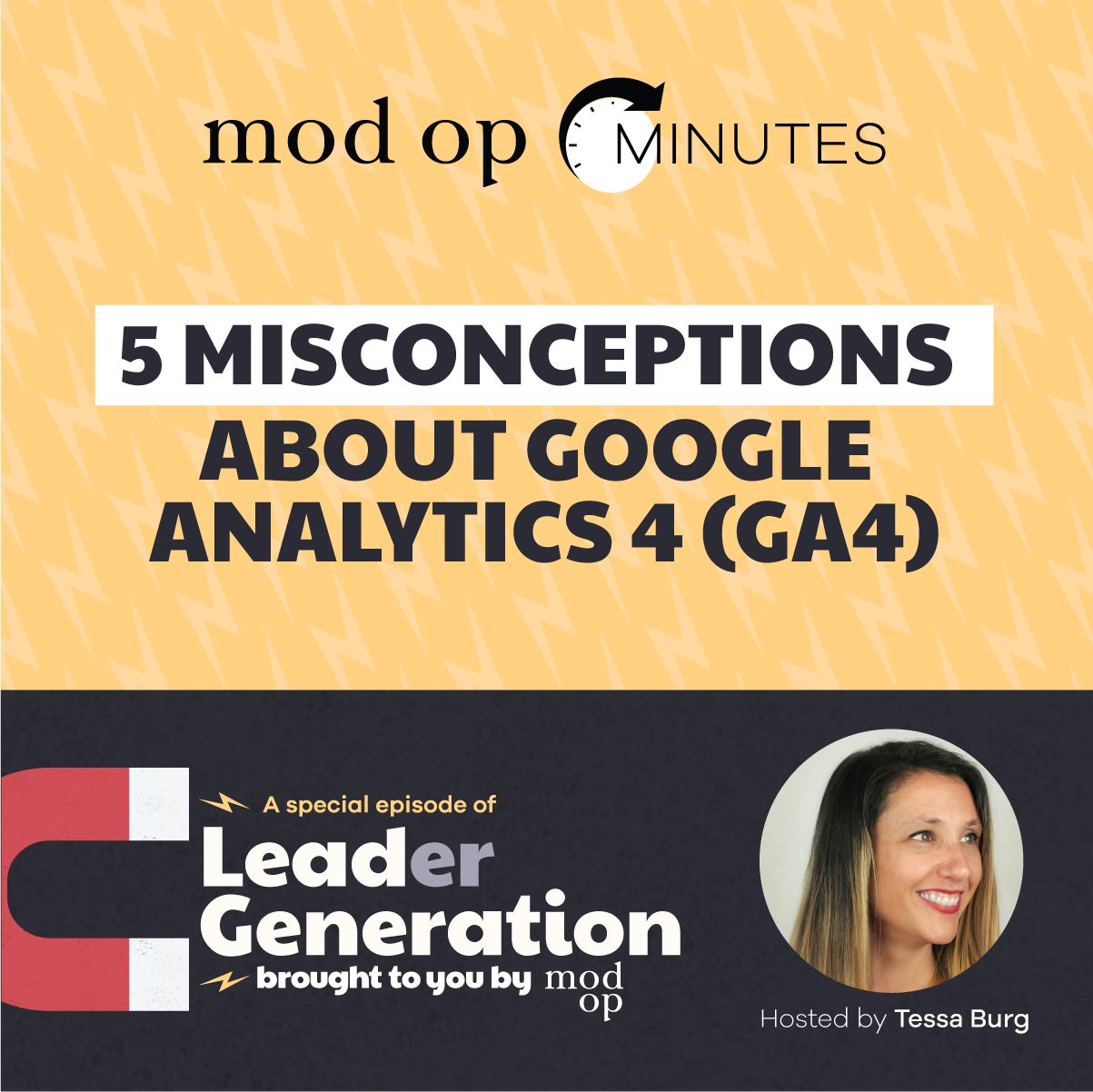Is Marketing The New Sales?
Tessa Burg
Chief Technology Officer at Tenlo

Salespeople have long been considered the face of a company. They sell products or services, negotiate deals and close the sale. In recent years, however, companies have begun replacing salespeople with marketers.
Today, marketing is often seen as the primary way to generate leads and increase sales. As a result, companies are investing heavily in marketing departments. And they’re also hiring more marketers than ever before.
How did this trend begin? What are the pros and cons? Is marketing really becoming the new sales? Join us as we explore a topic that’s continuing to change modern marketing.
Highlights From This Episode:
- Background of this trend
- Factors that accelerated this trend
- Pros and cons for marketing and sales
- New levels of marketing accountability
- Where we go from here
Watch the Live Recording
Cheryl Boehm: Hello, and thanks for listening to the Lead(er) Generation podcast. Today I’m here with Tessa Burg, who I’m sure you recognize because she’s the primary host of the show, she’s also the Chief Technology Officer here at Tenlo. Welcome Tessa to the show.
Tessa Burg: Thanks for having me. I’m excited to be a guest again.
Cheryl Boehm: Yay. All right, so we’re just gonna dive in because it’s interesting. There’s this phrase that we’ve been hearing a lot about in our industry lately and it’s marketing is the new sales and it keeps coming up over and over again. And I’m curious and would like your perspective of where you think that phrase originated.
Tessa Burg: Yeah, so I have to admit totally taking this topic from one of our clients and she is a genius, and when she said it during a meeting it really resonated and it really motivated me. I never thought I wanted to be in sales until she said, “Listen, we gotta show that marketing is the new sales.” And I was like, “yes.”
Tessa Burg: At the moment I didn’t know what I was waiting for has come. I think a lot has contributed to this and I’ll also say that… So the comment was made probably early January getting ready to do plans. And since then I’ve been looking for, you know, what has been the catalyst of a lot of marketers wanting to step into this role of being the new sales? Why is it important? Is this a good thing? Should we be responsible for sales? Is this something that B2B marketing is gonna help grow our industry as marketers as well as our businesses?
Tessa Burg: So, I had a lot of questions, I’ve done a lot of research but even though we’re having this conversation today I feel like I’ve only scratched the surface. So this will be very interesting to put this out there and get some reaction in few feedback from others and see what their perspective is and what they’ve learned as we’re going on this journey where one thing is for sure, marketing has more sales responsibility and more tools to close deals online than ever before.
Tessa Burg: So what I think primarily contributed to this is definitely the pandemic. I feel like there isn’t an episode that we have where we don’t talk about it.
Cheryl Boehm: Yeah.
Tessa Burg: But it forced us to start building relationships online, having more webinars instead of in-person trade shows and the people tasked with hosting those webinars coming up with the content, owning those relationships for marketers and coming out of that we’ve always been asked, what’s the ROI on this? Where can I see their return? So coming out of these new forms of content and for many of us they were new, they’ve always been around, but for some of us we were trying, you know, virtual trade shows and webinars. For the first time people wanted to see the return.
Tessa Burg: We just here alone, we did three customer portals that allowed our client to more directly engage and sell to customers. And that, you know, it’s the first time that’s ever happened here. I mean, we work on so many SEO and content and email and marketing automation and CRM projects, but during the pandemic, it was the first time it was all out commercial selling and commercial relationships online.
Tessa Burg: So you know, I think the pandemic is the number one trend but also the availability of the tech can… Like if we didn’t have access those applications, if they weren’t market or friendly, then it wouldn’t have been possible. And it can’t just be, you know, marketer-friendly for me who’s the CTO at a marketing company, it has to be marketing-friendly for the client. Us, like a lot of other service providers have the philosophy that we develop for our clients to take over and manage, you know, their new tool to really scale. And we’re always there to support, but to get the most out of any technology, there’s gotta be some things that are repeatable and scalable on the client side.
Tessa Burg: So I think when we took a step back and started being required to sell. You know, those tools, those applications were there. I think that another phenomenon that has always been there but became more important in this transformation was connectivity. So there’s so many platforms to choose from and whenever we’re building out, you know, a new tech stack specifically for portals or selling, we’re looking at what combination of tools works best for that client and in their environment.
Tessa Burg: So if you are on application that’s, you know, having a walled garden, you probably didn’t get picked up as much as applications that also integrate easily into some core platforms. ‘Cause lot of our clients are already on WordPress or HubSpot or Salesforce that almost everybody already has a core platform. And so a lot of the ability to use APIs in a really efficient way so that the customers experience could stay really seamless and it didn’t feel like they were leaving a place that they were already comfortable, that also allowed us to start really selling and selling in a way that the conversion rate might be at… Remains to be seen. I was gonna say higher than selling offline but I think we’re still a little too new.
Cheryl Boehm: Yeah.
Tessa Burg: You know, a little ahead of myself, but–
Cheryl Boehm: We, you can keep our fingers crossed and hope .
Tessa Burg: Yeah, yeah, kind of speaks to like sort of this momentum and motivation I’m feeling now .
Cheryl Boehm: Yeah .
Tessa Burg: Being in the driver’s seat of what drives revenue .
Cheryl Boehm: Well, and that’s a good point. So like what are your feelings about marketers taking more onus on that, on the sales process? Do you think that’s a good thing, a bad thing? What are your thoughts?
Tessa Burg: Yeah, so I think it’s a really good thing. I feel like for a large part of my career here at Tenlo, we’ve always been challenged to help show the value of our client’s marketing efforts. So if they’re doing SEO, if they’re doing a content strategy paired with a marketing automation nurture series, what we’re always looking to do is measure the contribution to pipeline. But that can be challenging in a lot of environments, again, because things aren’t connected ’cause we don’t have access to where the sale actually closes because distributors and wholesalers or brokers or retailers don’t share that final buy data.
Tessa Burg: So we’re trying to take, you know, data, we’re getting back an aggregate and say, how can we use the attribution management we have which is just measuring the steps that we can see in our funnel to try and bestimate, guesstimate what our contribution was. Where if we… If marketing is the new sales and we can sell directly online, we can see that sales close.
Tessa Burg: Now, if you have any attribution management model set up it’s much more accurate. You can use the simple tags in other words for ecommerce close. You know, things that I feel like consumer marketers and certainly I always took for granted on the consumer marketing side and ecommerce have really been a challenge on the B2B side. So I think it’s a good thing because it proves out the value of marketing.
Tessa Burg: I also think it’s one of the main drivers as to why we’re seeing this trend. You know, marketers in the last decade have much done a much better job of content marketing, of building that trust, of putting out data articles services that add value to their customers. And now customers are using those tools to compare their options online and has added convenience of just buy. If you can build enough trust and equity in your marketing with your content and your digital experiences then you are more likely to be able to sell online. And you can start cashing in basically on the value you’ve already built with that base. So I think it’s a good thing.
Tessa Burg: You know, we’re new. I don’t know, maybe in a year we can see and learn from some downsides that of sale directly but so far it’s just been really rewarding to be able to see a sale all the way through. And during the pandemic, you know, the amount people are willing to spend online on commercial services, professional services, went way up, again, not a necessity.
Cheryl Boehm: Yeah.
Tessa Burg: So it’s not just like these onesie-twosie one-offs. It was… You know, some commercial buyers went to the ecommerce version of their distributor wholesaler, some started using Amazon for specific types of things. And we’ve seen, you know, large growth in Amazon’s B2B universe. But those marketers who have been able to build that trusted equity right now have also had the opportunity to sell directly and are really reaping the benefits.
Cheryl Boehm: So you listed quite a few reasons why this is a good thing but there’s always got to be that other side. Like are there any potential pitfalls or challenges or things that maybe aren’t so good about marketing becoming the new sales?
Tessa Burg: Yes, so definitely. One, not everyone can do it. You know, that’s been a major blocker in some projects and you know, how do we know we have the inventory? Do we have the distribution to support selling directly? Are we gonna tick off the retailers or distribution partners? Because one thing’s for sure, partners, retailers are incredibly important. I think the piece that we really need to solve is, are we getting incremental sales by going directly and or how much are we cannibalizing from our partners?
Tessa Burg: You know, it’s different for every industry. I feel like we have some clients where having to see a commercial product, especially highly engineering technical products that are super duper large, at some point you are going be in person. Like, you know, there are specific types of equipment that is… Maybe if you’re rebuying it’s online and that could be a strategy, but I feel like the same is true for even on consumer products. But there is a rise in consumers wanting to buy more online and in channel where they’re already consuming the content that matters most to them.
Tessa Burg: So for example, social media, specifically Instagram. You know, one in four moms is on Instagram and the vast majority of them are following brands and products that they like. So they have elected to see this brand’s content, they wanna interact with it and then they’re buying because they’re already there, they already see, and it feels very natural just to buy directly from Instagram. Does that mean that one of the retail partners for that brand lost a sale? I don’t know. You know, like we’re looking at doing some regional tests right now to try and help our clients answer that question. But one thing that I feel like might be true is they may have never gotten the sale to start with had they not been on Instagram.
Cheryl Boehm: Yeah.
Tessa Burg: ‘Cause I know that, you know, for a lot of audiences product discovery starts on social and if I’ve already done enough comparing, you know, I’ll just share a personal story. I recently bought a bathing suit off of Instagram something I think I would’ve thought was always an in person purchase. You know, bathing suits gotta fit.
Cheryl Boehm: Yeah .
Tessa Burg:But there were really nice guides that helped me make sure I got the right size, I compared it to other suits, I had all their reviews in front of me, I loved the style that was tagged and so I bought it right from there. I feel like the same is going to be true of baby products. Like I might go to a store and sort of survey the land of all my options. Like I just remember building the registry for my kids and being overwhelmed by how much baby equipment there is.
Cheryl Boehm: Yeah, too many choices.
Tessa Burg:Yeah, way too many choices. But social media definitely helps you sort through that. So now I can go follow those brands, look at views, ask my friends. And yes, if you are in my channels where I’m already comparing products and saying I can buy it right there, then you’re getting that sale, so I’m not sure if, you know, are we cannibalizing is the right question. I feel like maybe we also have to measure, you know, how incremental is this sale or would I have lost this sale, you know, to a competitor? Because if your space hasn’t moved there, if your competitors are not selling in social channels or directly then I think there’s an opportunity for you to step in and get the sales, not to lose them. ‘Cause what we’ve certainly seen from the data is that audiences want to buy more online. It doesn’t mean everything, but the data suggests that they want to buy more online and they want to buy it in the places where they’re consuming content they trust.
Cheryl Boehm: Well, you mentioned the pandemic at the beginning of the show and it really has influenced how we behave today and into the future. And I think, you know, many of us were forced to turn to ecommerce ’cause we were all locked away at home and we just became more comfortable with it. And again, as personal consumers, some of that behavior translates into our B2B world. So I think people are becoming more comfortable with buying online, even if it is a service or a B2B product. Yeah.
Tessa Burg: And especially if it’s, you know, on the commercial side, on the B2B side. If it’s a product I’ve already bought, tested and used, like can I… If I’m getting content directly from the manufacturer, if I’m starting to build a relationship there, like do I have different options? Do I have a more direct relationship that benefits me differently than going through an intermediary? And not everyone does. Sometimes it makes way more sense to keep all your stuff with the distributor because it’s convenient.
Cheryl Boehm: Yeah.
Tessa Burg: You have a relationship, they have the expertise across product lines, you get… You know, there’s tons of benefits. But then in other cases where you just want that on autopilot and you want more direct support from the people actually making the product, you know, I think there… I mean, the data says there’s an appetite there. I think it’s for every company to look at and say, “Is there something unique that we’re providing that gives us the opportunity to go direct?”
Cheryl Boehm: So now that marketers are contributing more to sales, are they being held accountable for that? Are there certain goals now that they are being asked to hit like from the leadership of their teams?
Tessa Burg: Yes, absolutely. And it starts with first, you know, tell us who these customers are that are… That we either want to buy directly from us or that currently are because we need to understand more about them. And then how do we scale those efforts and scale them profitably? So when we’ve been faced with these questions, it’s been really exciting because we can see the data all the way through and we’ve seen our clients and us say, “Yes we’re ready to be held accountable and we want to be, we don’t have to, you know, beg for the closing data.” If you’re selling directly, you get it. And even if… You know, for those who don’t have the distribution or don’t have the access to inventory to sell directly directly, you know, you can get a better idea of where your customers are buying and the influence of your marketing by using some tools like a PriceSpider or a Prisync. Man, there are so many, now I’m blanking.
Cheryl Boehm: We can link to some of them too.
Tessa Burg: The channel site, yeah. There’s a bunch where, you know, it just doesn’t have to be perfect, but, you know, there’s… Selling directly, they checked out at my own shopping cart and then there’s… I put my content in the place I know they value most but I’m still sending them to buy online at the place that they prefer. And I feel like that’s what everyone needs to focus on, is you will get more sales overall if you are making your cart available where they want to buy. And then that also helps alleviate the cannibalization concern or some issues you might have with your partners. It is all about the customer’s gonna buy where they want to buy. Are you there? And if you’re not there, you’re not getting the sale. I think, yes, marketers are being held more accountable waiting into this gently ’cause nobody wants to tick anyone off. But overall, everyone has really like been open to that accountability and excited are those metrics and insights to help generate, you know growth at the highest level.
Cheryl Boehm: So if you’re on a marketing team and you really want to, you know, start becoming sales and start contributing to sales more, are there any steps you can take to start doing that?
Tessa Burg: Yeah. So here at Tenlo we have a market research arm, NSRC. They do a fantastic job of helping us and our clients where their consumers are shopping, what their needs and motivations are. And so if people have not done market research in a while I would highly recommend you refresh that because, you know, a lot has changed, a lot has been expedited where your customers shop today, their per reception of buying online has certainly shifted. I mean, I feel like before… Not I feel like, this is not a feeling, this is exactly how that was actually published. In a study that one of our clients contracted it said, you know, about 1% are going to actually buy commercial products online. And then during the pandemic the amount of actual commercial products bought online like was much higher than 1%. You know, we were–
Cheryl Boehm: Oh, yeah.
Tessa Burg: 10, 12, 13%, which is an enormous amount on growth. So there has been a shift, some shifts even larger than that in other industries. So I would start with some market research and really making sure you understand where your customer wants to buy ’cause that’s what it’s all about. Where do they want to buy?
Tessa Burg: Then the second thing is, you know, use digital tools to start looking at how they’re interacting with your content and your competitor’s content at different stages of the journey. So how are they using Instagram? How are they using LinkedIn? Are they using other more niche portals to really get connected to services and professional products within your space? Because everyone’s research when we closed down trade shows went online and people found some really interesting routes to make sure they were getting data before they bought. And I think we all started acting a little bit more like consumers. You know, we all started googling more. So search, you know, has always been important now, more important than ever. So my third recommendation is are you optimized for the questions your clients are asking?
Tessa Burg: So that market research can help with, looking at tools to see the overlap of where your audience goes to research versus where they buy versus where they get influence can certainly help and then make sure you’re putting in the work to build that trusting content on your website. You wanna have a really strong owned space so not everything is on rented land. And these are principles, you know, that we’ve lived by as we’ve grown in content marketing, but now they’re made more important to connect, to selling directly to the consumer or at least presenting them with options to buy where they want to buy directly from your content and your experience.
Cheryl Boehm: Yeah, those are great tips. And I think everyone can benefit from trying those and using those. So we’re about out of time. So before we wrap up, are there any last thoughts that you have?
Tessa Burg: I don’t have any last thoughts other than to say, I mean, it will would be really great to get some feedback on this and hear more about what other people have tried. I think marketing is entering a new era and it will be exciting to exchange ideas on how to better reach, measure and attribute sales now that, you know, we’re getting a little bit more action and play out there. So you can reach me at [email protected] or visit us at tenlo.com. Click on podcast, there’s a chat there that actually goes to Cheryl and I as well. Just topics, ask questions, maybe you wanna be a guest. Maybe somebody wants to be a guest and comments on this or join us for our office hours, which we just started, which is just an open discussion on topics we’ve covered in the podcast. So yeah, again, this was all like my perspective, my observations on what we’re seeing. So I’m really excited to keep this conversation going and help our clients accelerate their contribution even more.
Cheryl Boehm: Great. Like Tessa said, you know, you can contact us on tenlo.com and we would love to have you as a guest, hear your questions and thanks for tuning in and we will see you next time.
Tessa Burg: Bye.
Cheryl Boehm: Bye.
Tessa Burg
Chief Technology Officer at Tenlo

Tessa Burg is Chief Technology Officer at Tenlo. She’s been leading data-driven marketing and technology teams for 15+ years. Tessa has deep skills in many areas, including digital marketing, user experience, technology strategy and application architecture.
Tessa believes in taking a tech-agnostic approach to marketing development. It maximizes a client’s existing technology investment. Plus, empowers clients to easily use, manage, measure and scale their platforms on their own.


